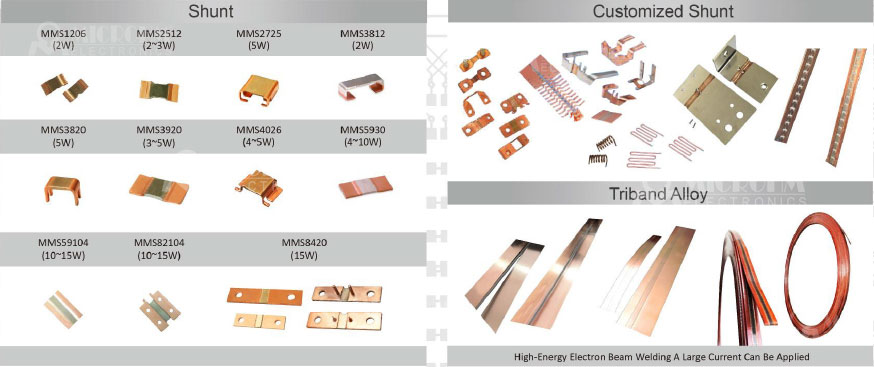Shunt Resistors for Current Sense
Ammeters are used to measure the AC or DC by measuring the voltage drop over a precision resistor with a known resistance. The current flow is calculated by using Ohm’s law.
Most ammeters have an built-in resistor to measure the current. However, when the current is too high for the ammeter, the ammeter is placed in parallel with an accurate shunt resistor - ammeter shunt which is a high precision manganin resistor with a low resistance value. The current is divided over the shunt and the ammeter, so only a small percentage flows through the ammeter. In this way, large currents can still be measured. By correctly scaling the ammeter, the actual amperage can be directly measured. Using this configuration, in theory the maximum amperage that can be measured is endless. However, the voltage rating of the measurement device must not be exceeded. This means that the maximum current multiplied by the resistance value, cannot be higher than the voltage rating. Also, the resistance value should be as low as possible to limit the interference with the circuit.

Shunt resistors have a maximum current rating. The resistance value is given by the voltage drop at the maximum current rating. For example, a shunt resistor rated with 100A and 50mV has a resistance of 50 / 100 = 0.5 mOhm. Other important parameters include the resistance tolerance, the temperature coefficient of resistance and the power rating.
It is important to carefully choose the position of the shunt in the circuit. When the circuit shares a common ground with the measurement device, often is chosen to place the shunt as close to the ground as possible.
Latest News
- Resistor's role in measuring and correcting LED,,,
- Single through-hole resistors' characteristics ,,,
- Why shunt resistors for current sense applicati,,,
- Metal-film resistors with small size, high resi,,,
- 36W High-Current Shunt Resistors MMS8420,,,
- 1W Surface Mount Resistor MPR1206,,,
- An Overview of Microhm Electronics' Resistor Pr,,,
- More anti-sulfur resistors used in harsh envir,,,
- Resistance changes with temperature,,,
- 140W TO247 High Power Heatsinkable Resistor,,,
- MMS5930 is ideal for current sensing in industr,,,
- Shunt resistors selection for engineers' design,,,
- Considerations for choosing precision resistors,,,
- Ceramic Encased Cement Resistors NWH Series for,,,
- Resistors for Passive Balancing in Battery-Pow,,,
Hot Articles
- Microhm will take part in 10th Automotive World,,,
- Thanks for Visiting Microhm's Booth E5-5706 in ,,,
- Resistors in Short Supply: Blame Cars,,,
- New lunch: High Power Precision Shunt Resistor,,,,
- How to Test a Resistor,,,
- Innovative Technology, Future Electric: Electri,,,
- What is Precision Resistors?,,,
- SMD Resistors Sizes and Packages,,,
- The Construction and Features of Metal Film Res,,,
- What is a TO-220 Resisor?,,,
- Hot Selling Products: Precision Shunt Resistors,,,
- How to Calculate the Equivalent Resistance Valu,,,
- What is a Fixed Resistor?,,,
- Resistors in LED Circuits,,,
- Resistors Types and Materials Overview,,,
Resistance applications
- Shunt Resistor MMS8420 for High Current Stable ,,,
- Heater Blower Motor Resistor in Air Conditioner,,,
- The Main Application for High Precision and Low,,,
- Miniature future for passive electronic compone,,,
- Why Zero-Ohm Resistors?,,,
- Difference Between High Precision Resistors and,,,
- The Measurement Accuracy of Automotive Shunt is,,,
- The Four Important Functions of Alloy Resistors,,,
- BMS for New Energy Vehicle,,,
- Precision Resistors' Construction and TCR,,,
- Industrial Roberts Applied to Solar Photovoltai,,,
- Select the Right Resistor for Harmonic Filterin,,,
- Carbon Film Resistors' Features and Application,,,
- Urbanization Development Bringing the Transform,,,
- Surface Mount Resistor's Size and Package ,,,
